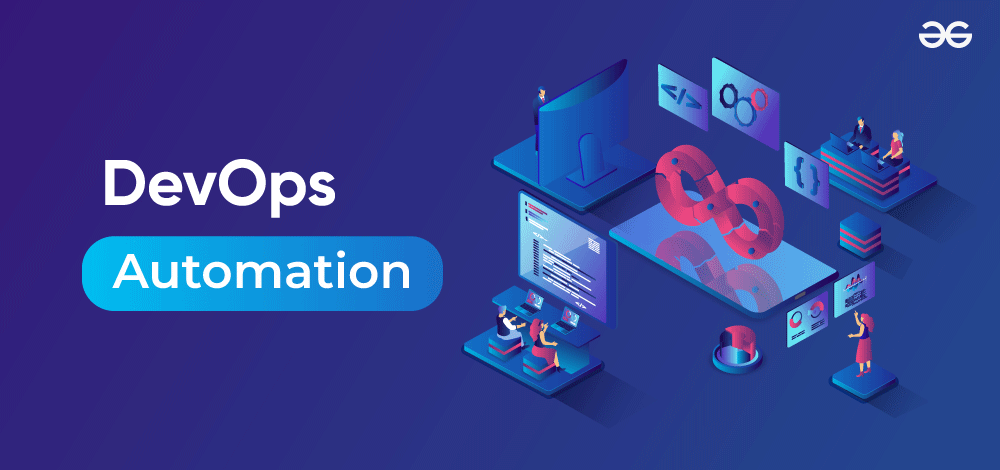Imagine a software team working on a website and following the same old traditional, non-DevOps practices like deploying an application to a server that requires many manual steps such as writing files, configuring settings, restarting tasks, etc.
The software development process is simplified by replacing manual tasks with efficient and automated workflows with DevOps Automation.
What is DevOps Automation?
DevOps automation refers to the systematization and computerization of manual processes such as coding, testing, and traditional deployment involved in the software development cycle. In a DevOps environment, automation can be used to integrate code, test, and continuously deliver software updates more quickly than ever before.
The idea is to promote alignment between the development and operation teams which in return increases the software delivery speed while providing higher reliability by reducing manual intervention. The major parts of DevOps automation include Continuous Integration and Delivery, Infrastructure-as-Code (Iaac), and automated testing – they all lead to not only faster software development but also a more responsive system.
Why is Automation Important in DevOps?
Automation is crucial in DevOps for several reasons. Three key aspects highlight its significance as discussed.
1. Minimizes Duplications
In DevOps, automation reduces redundancy by making processes more consistent. Repetitive jobs like code deployment or system configuration are easily prone to errors and inconsistencies when performed manually. Automation eliminates redundant effort and forces standardization through development and operations. It not only increases efficiency but also reduces the possibility of discrepancies that could result in a manual repetition of tasks.
2. Provides Proper Guidelines
DevOps automation provides clear and defined prescriptions for each stage of the software development life cycle. By using automatic tools like Infrastructure as Code (IaC) and scripting, teams can standardize workflows. These guidelines provide a map for designing, implementing, and operating infrastructure. They reduce ambiguity as well as increase cooperation between subjects that otherwise would have less mutual understanding. Teams can work together more effectively under proper instructions which results in improved communication and better awareness of the system development and operating status.
3. Reduces Risks
Risk reduction within the DevOps pipeline is dependent on automation. Manual processes are error-prone, and inconsistencies can cause deployment failures which leads to operational problems. Testing, continuous integration and deployment pipelines find problems early in the development cycle. Repetitive tasks are automated to minimize the risk of errors, improve software releases and enhance system stability through DevOps automation.
What are the Benefits in DevOps Automation?
DevOps automation offers many benefits that greatly improve the software development and delivery process. Here are some of the main benefits:
- Enhanced Productivity: DevOps automation quickens the development lifecycle by automating time-eating and repetitive duties which allow teams to focus on new product development and shipping more quickly.
- Increased Stability: Automation ensures consistent and standardized processes across the development cycle, testing phase, and deployment environments. This reduces manual errors and promotes reliable and predictable workflows.
- Faster Time to Market: With DevOps automating code integration, testing, and deployment, the time to release new features and updates is shorter. This agility in the development process means quick release of software products into the market.
- Improved Communication: Automation promoted by DevOps improves communication between development and operations teams. On the contrary, it makes possible for both teams to cooperate and divide responsibilities, so that each team better understands what the other side needs.
- Enhanced Quality: This is contained within the concept of DevOps automation. If testing is carried by automated procedures, then all changes to the code can be thoroughly and uniformly tested which in-turn helps produce better-quality code. In DevOps automation, problems are detected early in the development cycle, before further damaging effects could occur.
What are the Different Types of Automation in DevOps?
There are different types of automation that can be implemented at various stages according to the principle of software development cycle. Here are the important forms of automation commonly utilized in DevOps:
- Infrastructure as Code (IaC)
- Configuration Management
- Continuous Integration and Continuous Delivery (CI/CD)
- Continuous Monitoring
Let us understand each type of automation in detail below.
1. Infrastructure as Code (IaC)
Infrastructure as code is a process of automating the infrastructure so that developers do not need to manage servers and storage when they want to deploy the application each time. It enables consistent and repeatable infrastructure deployments which minimizes disruptions when deploying the code. IaC allows teams to control complex infrastructure more easily, while integrating into software life cycle management.
The popular tools for infrastructure as code are:
- Terraform
- CloudFormation
- Ansible
- Pulumi
2. Configuration Management
Configuration Management is a process of automating configuration tasks like maintaining the computer systems, servers, etc which reduces the manual errors in various IT cases. It ensures consistency across environments and simplifies adjustments.
The popular tools used for configuration management are:
- Ansible
- Chef
- Puppet
- Salt Stack
3. Continuous Integration and Continuous Delivery (CI and CD)
Continuous Integration and Delivery automates the deployment of code which speeds up the delivery of the software application lifecycle and reduces integration errors in the app.
The popular tools used for CI/CD are:
- Jenkins
- Spinnaker
- GitLab CI/CD
- AWS Code Pipeline
4. Continuous Monitoring
Continuous Monitoring automates the tracking of application systems which is majorly done by release managers. It identifies the bugs and detects any early troubles that affect the users.
The popular tools used for continuous monitoring are:
- Datadog
- ELK stack
- Grafana
- Prometheus
What are the Best Practices for DevOps Automation?
Best practices help in simplifying software applications management lifecycle and improving operational efficiency. These practices help to speed up the development cycle in order to receive quick results. Here are the following tips that will make your DevOps journey smooth sailing.
- Using CI/CD: Establish a Continuous Integration/Continuous Delivery (CI/CD) pipeline for creation, testing, and deployment. This streamlines the delivery process, ensures code quality, and accelerates the release cycle.
- Foster a culture of collaboration: Break down organizational silos and develop a culture of collaboration and flawless communication. Encourage cross-functional teams to work more closely together while promoting shared responsibility for success.
- Automation Priority: Prioritize automation in all aspects of the development lifecycle. Automate tasks such as infrastructure provisioning, testing, and deployment to increase productivity, reduce manual errors, and keep teams focused on innovation.
- Embrace Agile methods: Embrace agile methodologies to facilitate iterative improvement and ongoing feedback. This approach allows teams to quickly adapt to changing needs while providing increased value to users.
- Set up a functional test: To ensure code quality, use automated testing to identify bugs early in the development process. Automated testing provides rapid feedback, allowing teams to rapidly address issues and maintain high-quality software.
- Focus on analytics and observability: Emphasize monitoring and monitoring capabilities to gain insight into system performance. Early diagnosis allows problems to be identified early, enabling teams to respond quickly and maintain the health of the system.
Conclusion
DevOps automation stands as a transformative pressure in the realm of software program improvement that revolutionizes traditional practices. By replacing guide, time-ingesting tasks with streamlined and efficient automatic workflows, DevOps automation considerably quickens the software improvement existence cycle. The integration of development and operations, coupled with a focal point on collaboration, communique, and non-stop transport, marks a paradigm shift inside the enterprise. This approach not simplest enhances the speed and quality of software program shipping however additionally fosters a tradition of innovation, adaptability, and non-stop development. As organizations increasingly more embrace DevOps automation, they role themselves at the leading edge of agile, responsive, and excessive-performing software program improvement practices.
FAQs – DevOps Automation
1. What is DevOps?
DevOps is an approach which connects software development (Dev) and IT operations (Ops). The basic idea can be summarized as the Seamless Flow of Information along with Continuous Delivery. This emphasizes collaboration, communication and automation workflow design goes from.
2. What are the best tools for DevOps Automation?
The configuration of DevOps automation and specific requirements determine the choice of tool. Some widely used tools are: Git for version control, Jenkins, GitHub Actions for CI/CD, Ansible for configuration management, Docker for containerization and orchestration, and Terraform for Infrastructure as code.
3. What is a DevOps Automation Engineer?
A DevOps Automation Engineer’s role is to design and build the tools required, as well as create various automated processes in order to automate some parts of business. To get by as a DevOps Automation Engineer, one needs to master software development and IT operations procedures.
One also has to have experience in using automation tools or scripting languages such as Bash syntax which are key roadblocks removing barriers between the different processes of quality testing etc across their pipeline-make them easier for engineers smoothly flowing through this complex but efficient process via practice will help transform.





